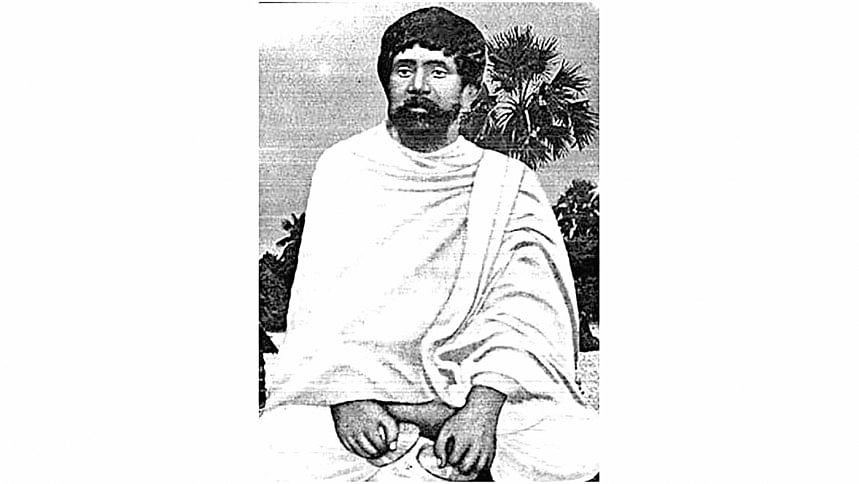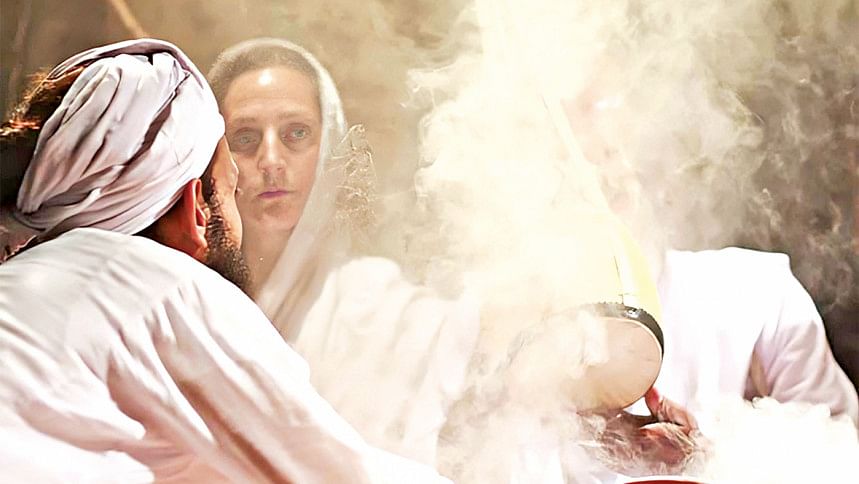In a jungle by a wide river bank, a small group is sitting amongst the dangling roots of a luscious banyan tree. The single-stringed ektara, four-stringed dotara, wood-bead necklace mala, hand-spunned bright-coloured cotton gamccha and white outfits identify the members as Bauls, the traditional mystic musicians of Bangladesh. Suddenly a group of youngsters, citydwellers judging by their modern clothes and gait, arrive on the scene. After some bargaining, they are taken along to embark a boat. Musical instruments are pulled out, and music starts. The sweet melody of the bamboo flute is soon joined by other instruments, both traditional and modern. The singer voices the refrain: "when Ālif hits, Mīm's body gets hurt / If you want to see the Prophet, come do come".
This music video was released for Eid-ul-Fitr 1444 (2023). It was presented by the production team as a very rare composition of Fakir Lalon Sain, the 18-19th century saint of Chheuriya, Kushtia. The signature in the last couplet also points at such: "Fakir Lalon tells you all, first get a Pir-murshid, only then go visit the city of Mīm, you'll understand what God means". But as it turns out, this song … is not Lalon's. This problem is, although not new, very real, and very common. It touches on issues of social habits and cultural politics. It also interestingly eludes clear-cut answers of right and wrong. As such, it touches on the issue of ownership in folklore practices, questions cultural authority, bears witness to the multifarious poetic expression of taboos up to today, and of course springs from the yearning for popularity and legitimacy.
The etymology of "baul" is still an unsure topic. Historically predating the intoxicated "batul" as linked to "batash", the wind, two words found in Charyapada, "bazil" and "bazule", pointing to the merciful aspect of the guru, may actually show the root of the word. Those who regularly interact with "Lalon content" as an intellectual practice, are most likely to develop the intuitive understanding of that metaphorical salty taste, finding the connection with the "bazil".

Art as a social language
Those who are familiar with traditional popular culture of rural Bangladesh will probably easily picture philosophical and social debates. Through singing and dancing on open areas (no walls, and obviously no fourth wall), jatra and pala are two forms that come to mind. The opening set-up and conclusion of these acted-out narratives were most likely predefined. Just as structure allows for freedom, habits and taste are acquired through repetition. And variations in the development of the storyline and unrolling of the intrigue create surprises to keep the audience engaged.
For the sake of setting context, let's risk a detour with Gostho Leela as an example from the Baul-Fakir lineage. Gostho Lila is the staging of Krishna's childhood as he is called from his mother's embrace to join the cowherders. Gostho has two meanings, which enables both literal and philosophical understanding: it may refer to pasture, as well as society or tribe. Leela refers to a playful mystery – or a mysterious game. The characters of Gostho Leela are Krishna as Gopal, his mother Ma Joshoda, the cowherders who either speak as a group (chorus) or as individuals, and a narrator, the "Voice". It invariably begins with a description by the Voice of the dawn of the day, and the crowdherders calling to Krishna to wake up. It follows with an intense argument between the herders, Joshoda who is reluctant to let her precious son go, and Krishna, who oscillates between staying comfortably with his mother, and going to the outside, masculine world. As it is practiced in the sadhusongos which I have been lucky enough to attend, Gostho Leela always concludes with a deep plead to the mother, which gives the illusion of letting her decide.

Ownership in folkloric practices
Since improvisation was an important part of these events, there were a few common tropes, go-to intrigues, characters, metaphors and linguistic clichés, that everyone was familiar with. They would come in handy to advance the debate or narrative, as well as serve as fillers to rely on while searching for innovation. These common tropes would be taken from the different currents that met in the Nadiya region, including Vaishnavism, Sufism, and Shahajiya, amongst others. Looking at the corpus of devotional songs, we find recurring metaphors of the guru's role as guide and gatekeeper, as alchemist turning iron into gold; and the disciple's plead as a sinner, good-for-nothing blind mendicant. In the corpus of songs with philosophical or practical teachings, we find metaphors of concepts and rituals, such as the muqatta'at ("mysterious letters") 'alif-lām-mīm' at the core of the song used as an example in the introduction.
I would even argue – yet without solid proof, only from intuition and observation – that some paragraphs, if not entire songs, would be considered to entirely belong to the "community", with the performer merely posing their name as the signature, the bhonita, at the end of the song. The point here is that these common tropes and storylines are not owned by a particular performer, nor even by a specific community – they may come up and be articulated in various ways by various performers as per the needs of the performance. But they travel from ear to mouth through generations of practitioners. And so, just as a "false" reiterated enough times tends to become a "true", once a bhonita has been endorsed, so to speak, by figures of authority within the community, they stick. "Chander gaye chad legeche" ("The moon has touched the Moon-body"), which is Sarat Baul's according to some, for others Madan Shah Fakir's; "jat gelo jat gelo bole" ("they say the caste is lost") by Goshai Gopal; Mukundu Das's "ki sandhane jai sekhane, moner manush zekhane" ("on which quest do I go, to find the Human of the Heart"); or Manomohan Dutt's "esob dekhi kanar hat bazar" ("it's all just a market of blind people"), are examples of how the cultural category "Lalon" has absorbed others' creative output, and authority.
Bauls on a whim
In "Bratya Lokayat Lalon", West Bengal anthropology legend and subaltern studies pioneer Professor Sudhir Chakraborty traces the beginnings of Fikir Chand (which can be roughly translated as 'Gadget Moon'), the first Baul band. Founded by social reformist and journalist Kangal Harinath along with some of his educated friends, Fikir Chand heralded a new chapter, which could be called 'Bauls on a Whim'. From Fikir Chand on, writing and singing folk songs became entertainment, sectioned off from hardcore spiritual discipline and renouncement. Nor did the songs need to carry structured soul-searchings or deep philosophical teachings anymore. Poetic aches, resilience when confronted with the natural occurrence of pain, with a touch of mystical wordings, were enough. With some knowledge of folk themes and expected level of language, and a good grasp on popular taste, one earned the right to wear the garb of the gerua-clad Bauls and white-clad Fakirs part-time, raise an ektara towards the sky and sing and dance for the sheer pleasure of the village crowds. Gorib Chand ('Poor Moon'), Ajob Chand ('Wonder Moon'), Roshik Chand ('Juicy Moon'), Balak Chand ('Boy Moon') soon followed as offshoots and competitors to Fikir Chand in the newly-created market…
Professor Chakraborty shows how, in the quest for legitimacy, using popular bands' names as bhonita to one's own composition, or to anonymous, "public domain" compositions, started right then and there. The heart of the problem then is not so much that Lalon Sain may still be gifting us new musical compositions from the depth of his mausoleum. It is not even that "Lalon" has become a false, but dangerously invasive, endorsement. Professor Chakraborty narrates how Harinath went to Lalon Sain to get his approval on some of Fikir Chand's new songs. Lalon Sain is said to have listened intently, and at the end, to have smiled: "the composition is just fine, but it lacks salt a bit". Taste is something that requires both cultivation and opportunity to develop… And taste is exactly where the shoe pinches.

Culture as a mirror: the heavy weight of projections
Most contemporary writers haven't failed to report the judgmental stance and clear dislike many colonial and high-society observers used to display when interacting with Baul-Fakirs in the 17th-18th century. Spending a limited amount of time on social media shows that the prejudice still runs through public consciousness: for most Bangladeshis, Kushtia means cannabis, and Lalon means sex. And as the saying goes… sex sells. Although Bangladeshi society has rapidly evolved in the past decade(s), intimacy is still very much a taboo. And as a mirror to what tantra has come to mean in the West, many of the popular Baul songs using the name of Lalon are both capitalising on and highlighting the social unease.
A few months ago, on a popular Facebook group supposedly dedicated to Lalon Sain, where most content also pertains to the libidinous category, someone used a picture of my husband and myself (without permission), to illustrate a song describing the different types of men and women according to, amongst traditional sources such as the Kama Sutra – chitrini (the beautiful one, which becomes chintamoni in the song – the thoughful gem), padmini (lotus-like), hastini (elephant-like) and sankhini (conch-like) for the women, shashak (rabbit-like), mrig (chicken-like), ashvo (horse-like) and brisho (ox-like). The last verse of that song, completely unrelated to the other two, narrates Lalon exhorting the momeens, the believers, to practice religion… This is similar to bringing disparate jigsaw pieces from different puzzles together only because the cuttings fit more or less, in the hopes of likes, shares and views…
New songs posing as Lalon's in the search for popularity, and old songs whose composers have been overshadowed by the social power of Lalon, are two aspects of the issue. There is a third one, which is not merely about the plausible mistakes and unwilling transformations that can happen when listening. As an established popular singer once told me, exercising freedom with the songs is essential to his practice. This may mean rearranging the verses and consciously changing words when they are either not easily understood or completely misunderstood by untrained public. A stark example for this is in Lalon Sain's "Manush guru nistha jar" ("Those who focus on the human guru"): in the chorus, the word siddhi, which used to mean spiritual boons or powers but has come to mean cannabis, is generally replaced with siddho, which means cooked or, in this case, successful. There are other cases – replacing mohajog ("high union") with mohajon ("great person") for example.
Bauls caught between tradition and modernity
The etymology of "baul" is still an unsure topic. Historically predating the intoxicated "batul" as linked to "batash", the wind, two words found in Charyapada, "bazil" and "bazule", pointing to the merciful aspect of the guru, may actually show the root of the word. Those who regularly interact with "Lalon content" as an intellectual practice, are most likely to develop the intuitive understanding of that metaphorical salty taste, finding the connection with the "bazil". Unfortunately, most are happy with the intoxication, simply consuming a cultural product laden with projections, without looking beyond superficial entertainment, momentaneous soothing and titillation.
This is where painful disconnection happens: sadhus are forced to compete with entertainers, standing behind a microphone on stage, and entertainers are expected to become sadhus, in a sad mimicry of the inseparability of creativity and religion that was central to ancient civilisations… In discussions with the rare non-dogmatic Fakirs and Bauls on the issue, quite spontaneously the question comes up: "If this song is not Lalon's, then whose is it?" Just as reality defies certainty, parampara, guru-disciple lineage, defies both orthopraxy and orthodoxy. So, the symmetrical question should probably be: "whose is Lalon?"
Other questions come tumbling. How does a living tradition adapt to changing times to remain relevant, while keeping true to its essence? And who defines ownership in what UNESCO has classified as "cultural heritage"? Do the artistic forms in and of themselves need efforts in conservation? Or do the deep, unconscious cultural or social necessity from which art sprang need deep debating and adaptation in practice? At the root, a question comes up, which is central to many struggles and disagreements all over the human world throughout the ages: is there such a thing as "purity", and if there is, who defines it, and how?
Deborah Zannat is a Baul-Fakir disciple, Lalon Shah's lineage.



Comments